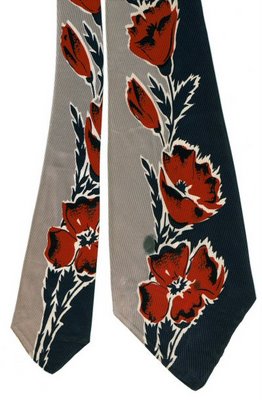
Continuing a kind of theme (a pseudo theme, perhaps?) from last week, I present another tie with a Hawaiian connection. The seller's label on this tie reads:
Popular Clo. Co. Ltd.
Honolulu, T.H.
Of course, this is a seller label, not a manufacturer label, so the connection with Hawaii is somewhat tenuous. That is, the design of the tie has no apparent Hawaiian connection, unlike last week's tie. But this tie, at least, can be presumed to have
BEEN in Hawaii, while a tie whose design is intended to
LOOK Hawaiian, need never have actually been near the place physically.
So which form of Hawaiian-ness is the more authentic? I'll leave that decision for the existentialists or ontologists among you
T.H., one presumes, stands for Territory of Hawaii. Since this is presumed to be a 1940's era tie, Hawaii was not yet a state at the time of its original sale. Statehood for Hawaii would not come until 1959, 7 months after Alaska's statehood, but 47 years after the next most recent state to attain that rank, Arizona, which became a state in 1912.
Now, back to the tie itself. What are those grayish shapes scattered about? Are they paisleys? Depends on how you define the term, I suppose, but they most I'd give you is that they are paisley-shaped. Here are a couple of definitions of paisley that I like:
Paisley is a droplet-shaped vegetal motif, similar to half of the T'ai Chi symbol, the Indian bodhi tree leaf, or the mango tree. The design originated in India . . .
An oriental pattern motif which is shaped like a teardrop, rounded at one end with a curving point at the other. Generally the inside of the teardrop shape contains many abstract designs, many of Indian or oriental origin.
Based on these definitions, I'd have to say that the grayish shapes on this tie are teardrop shaped, not paisleys.
Now, however, consider the larger shapes, with their white backgrounds, inside of which the grayish teardrop shapes find themselves, surrounded by red blobules. These larger shapes, perhaps, meet the definition of paisley. They too, are teardrop shaped, and they are filled with abstract designs, though whether of an Indian or oriental origin could be debated.
So, might I be justified in describing the pattern on this tie as pseudo-meta-paisley? Maybe, at least if I keep my tongue tucked firmly in cheek.
 Nothing says summer quite like sunflowers. These may not be depicted in their natural colors, but they do, nevertheless, suggest the rays of the summer sun, reflected in and symbolized by the sun-like shapes of the sunflower blossoms, and, frankly, by the waving stalks of grass, which also resemble tongues of flame streaming out from the sun's corona.
Nothing says summer quite like sunflowers. These may not be depicted in their natural colors, but they do, nevertheless, suggest the rays of the summer sun, reflected in and symbolized by the sun-like shapes of the sunflower blossoms, and, frankly, by the waving stalks of grass, which also resemble tongues of flame streaming out from the sun's corona.








